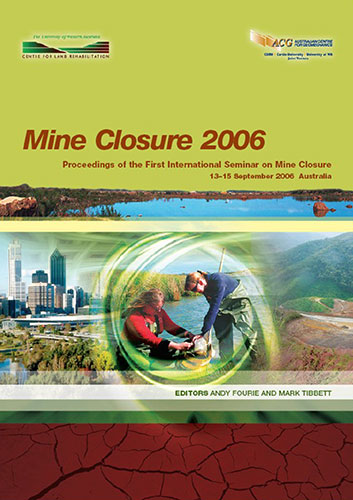Investigating the Linkage Between Water Fluxes, Geochemistry and Water Quality in the Post-Closure Landscape of the Mt Leyshon Mine, Queensland

|
Authors: Edraki, M; Baumgartl, T; Haymont, R Paper is not available for download Contact Us |
DOI https://doi.org/10.36487/ACG_repo/605_56
Cite As:
Edraki, M, Baumgartl, T & Haymont, R 2006, 'Investigating the Linkage Between Water Fluxes, Geochemistry and Water Quality in the Post-Closure Landscape of the Mt Leyshon Mine, Queensland', in AB Fourie & M Tibbett (eds), Mine Closure 2006: Proceedings of the First International Seminar on Mine Closure, Australian Centre for Geomechanics, Perth, pp. 647-656, https://doi.org/10.36487/ACG_repo/605_56
Abstract:
Since the closure of Mt Leyshon Gold Mine in Queensland, the quality of surface receiving waters in the mine area has significantly improved. However, uncovered stockpiles of mill rejects (scats), partially covered heap leach material, and covered waste rocks and tailings remain as potential sources of low pH waters with high concentration of sulfate ions, high metals (cadmium, copper, zinc, manganese), and arsenic. This study reviews the site geochemistry and water quality data and presents a recent assessment of the cover performance with the aim of a better understanding of the post-closure system. The linkage between water quality and geochemistry is established by mine water fingerprinting which shows that seepage sumps at the base of tailings, waste rock dumps and scats stockpile have distinctive chemical characteristics that can be related to the source. A re-assessment of the dry cover systems on the tailings and waste rocks shows greater infiltration rates compared to the previously predicted figures. Discharge of poor quality waters is related to water flux through the covers and interaction of infiltrating waters with geochemically reactive waste materials. Based on the Mt Leyshon experience, it is suggested here that revisiting of rehabilitation measures and monitoring systems in a post-mining landscape are necessary for prioritizing and improving management strategies. It is also shown that empirical models based on historic water quality data can be useful to post- closure monitoring. This paper is a first attempt to bring together major elements of the post-closure system and their correlations. However, more accurate linkages would require further information, most importantly, on flow rates and a better understanding of the hydrogeology of the site.
References:
ANZECC (2000) Water quality guidelines for livestock drinking water:
Bowell, R.J. (1994) Arsenic sorption by Iron oxyhhydroxides and oxides. Applied Geochemistry, 9, pp. 279-286.
Environmental Geochemistry International Pty Ltd (EGi) (1999) Mt Leyshon Gold Mine: A Geochemical Assessment
of the Old North Tailings Dam and Decommissioning Strategy, July 1999, Document No. 4651/410.
Flicklin, W.H., Plumblee, G.S., Smith, K.S. and Mchugh, J.B. (1992) Geochemical classification of mine drainage and
natural drainage in mineralized areas. In: Proceedings of the Seventh Water-rock Conference, Utah, A.A.
Balkema, Rotterdam, pp. 381-384.
Levington, A.A. (1974) Introduction to Exploration Geochemistry, Applied Publishing, Calgary.
Miller, G., Lyons, W.B. and Davis, A. (1996) Understanding the water quality of pit lakes. Environmental Science and
Technology, 30(3), pp. 118A-123A.
Morin, K.A. and Hutt, N.M. (2001) Prediction of minesite-drainage chemistry through closure using operational
monitoring data. Journal of Geochemical Exploration, 73, pp. 123-130.
Newberry, T.L. (1998) Weathering history and supergene gold transport in the Mt Leyshon deposit, northeast
Queensland, unpublished honours thesis, The University of Queensland.
Orr, T.H. and Orr, L.A. (2004) Mt Leyshon gold deposit, Charters Towers, Queensland. CRC LEME.
Contaminant Risks and Off-Site Impacts
Mine Closure 2006, Perth, Australia 655
Roseby, S. (2000) Internal memorandum, Mt Leyshon Gold Mine Ltd.
Scott, K., Li, S., Fraser, S., Campbell, I.D., Anand, R.R. and Robertson, I.D.M. (1996) Charters Towers-North
Drummond Basin Field Excursion (Field Guide) AMIRA Australian Mineral Industries Research Association
Ltd.
Woodward-Clyde Pty Ltd (1993) Scats analysis preliminary test work, report for Mt Leyshon Gold Mine Ltd.
Investigating the Linkage Between Water Fluxes, Geochemistry and Water Quality
in the Post-Closure Landscape of the Mt Leyshon Mine, Queensland
M. Edraki, et al.
656 Mine Closure 2006, Perth, Australia
© Copyright 2025, Australian Centre for Geomechanics (ACG), The University of Western Australia. All rights reserved.
View copyright/legal information
Please direct any queries or error reports to repository-acg@uwa.edu.au
View copyright/legal information
Please direct any queries or error reports to repository-acg@uwa.edu.au